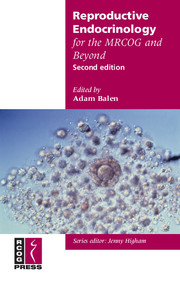Book contents
- Frontmatter
- Contents
- Acknowledgements
- Preface to the first edition
- Preface to the second edition
- Abbreviations used in this book
- 1 Sexual differentiation: intersex disorders
- 2 Adrenal disorders
- 3 Normal puberty and adolescence
- 4 Abnormal puberty
- 5 The menstrual cycle
- 6 Disorders of menstruation
- 7 Amenorrhoea
- 8 Polycystic ovary syndrome
- 9 Health consequences of polycystic ovary syndrome
- 10 Anovulatory infertility and ovulation induction
- 11 Lactation and lactational amenorrhoea
- 12 Hyperprolactinaemia
- 13 Thyroid disease
- 14 Diabetes
- 15 Lipid metabolism and lipoprotein transport
- 16 Premature ovarian failure
- 17 Calcium metabolism and its disorders
- Appendix: Endocrine normal ranges
- Further reading
- Index
11 - Lactation and lactational amenorrhoea
Published online by Cambridge University Press: 05 August 2014
- Frontmatter
- Contents
- Acknowledgements
- Preface to the first edition
- Preface to the second edition
- Abbreviations used in this book
- 1 Sexual differentiation: intersex disorders
- 2 Adrenal disorders
- 3 Normal puberty and adolescence
- 4 Abnormal puberty
- 5 The menstrual cycle
- 6 Disorders of menstruation
- 7 Amenorrhoea
- 8 Polycystic ovary syndrome
- 9 Health consequences of polycystic ovary syndrome
- 10 Anovulatory infertility and ovulation induction
- 11 Lactation and lactational amenorrhoea
- 12 Hyperprolactinaemia
- 13 Thyroid disease
- 14 Diabetes
- 15 Lipid metabolism and lipoprotein transport
- 16 Premature ovarian failure
- 17 Calcium metabolism and its disorders
- Appendix: Endocrine normal ranges
- Further reading
- Index
Summary
Lactation is a state of profound importance for both mother and baby. In addition to the advantages conferred on the baby by breastfeeding (prevention of infection, improvement in gut motility, protection from necrotising enterocolitis, reduction of some adult diseases and possibly reduction in cot death), there are marked physiological, endocrine and metabolic effects on the mother.
Initiation of lactation
During pregnancy the breasts develop rapidly under the influence of placental steroids, particularly estrogens, permanently altering the breast architecture. The breast of the nonpregnant woman consists mostly of adipose and connective tissue; by late pregnancy alveolar tissue predominates. Each alveolus is enclosed in a net of myoepithelial cells; the alveoli themselves drain into the lactiferous ducts, which drain each lobe of the breast and open via the lactiferous sinuses into the nipple (Figure 11.1).
Following the birth of the baby, milk production, although present from the second trimester onwards, accelerates rapidly in response to the fall in plasma progesterone, the high levels of which during pregnancy inhibit full lactation. Colostrum, a thin yellowish fluid high in protein and immunoglobulin A, is produced initially, providing resistance to gastrointestinal infection. The composition gradually changes to ‘mature’ milk after about 48 hours and is associated with an observed rise in serum prolactin concentrations. Mature milk contains higher levels of fat and carbohydrate and lower levels of protein and immunoglobulin than colostrum.
- Type
- Chapter
- Information
- Reproductive Endocrinology for the MRCOG and Beyond , pp. 137 - 142Publisher: Cambridge University PressPrint publication year: 2007

